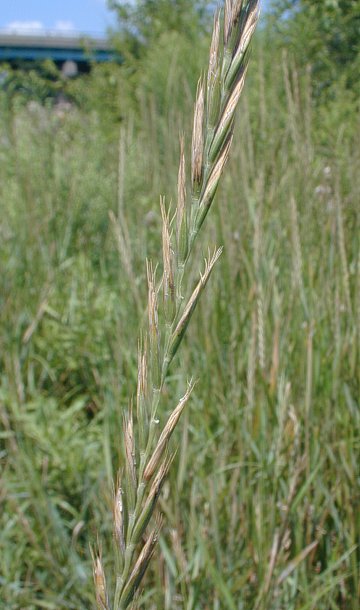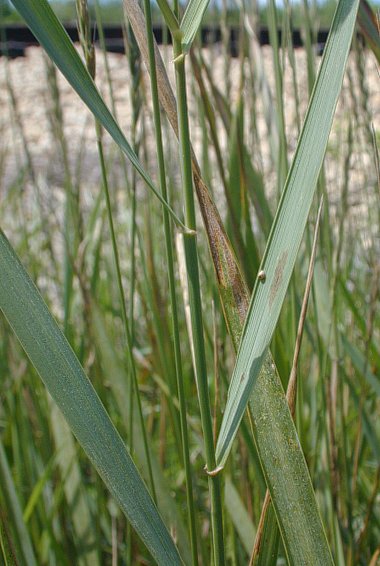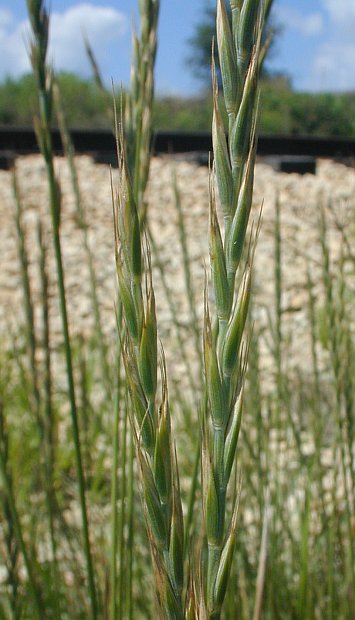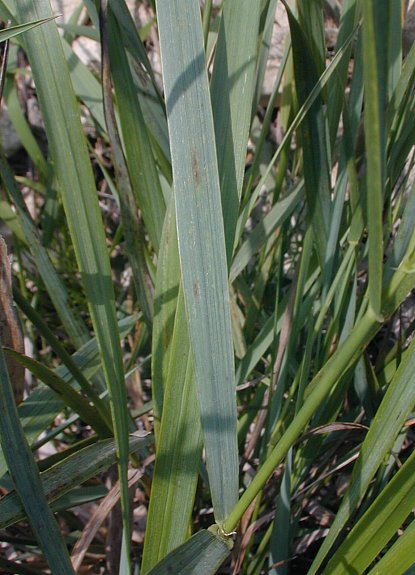Description: This perennial grass is about 2-3' tall and unbranched, although it may tiller at the base and send up multiple culms. The culms are green, terete, and glabrous. Along each culm, there are 3-5 alternate leaves. The leaf blades are up to 10" long and 10 mm. across; they are ascending or slightly arching and somewhat stiff. The upper blade surface is grayish blue, hairless to sparsely short-pubescent, and slightly rough-textured, while the lower blade surface is medium green, hairless, and more smooth-textured. At the base of each leaf blade, there is a pair of slender auricles (ear-like lobes) that wrap around the culm. The leaf sheaths are dull green and either hairless or short-pubescent. The ligules are short-membranous. The culm terminates in a spike-like raceme up to 8" long that is stiff and erect. Along this raceme are spikelets up to 20 mm. long that alternate along each side of its rachis on short peduncles; these spikelets are appressed-erect to strongly ascending. Immature spikelets are dull green to grayish blue, while mature spikelets are light brown or stramineous (straw-colored).

Each spikelet consists of a pair of glumes at the bottom and 3-7 florets with their lemmas above. In each spikelet, the lemmas are arranged into 2 overlapping ranks. The glumes are about 8-11 mm. long and linear-lanceolate in shape; they have several fine longitudinal veins along their convex outer surfaces. The tips of glumes are acute and awnless. The lemmas are about 8-11 mm. long (excluding any awns) and linear to linear-lanceolate in shape; they have several fine longitudinal veins along their convex outer surfaces. The typical form of Quack Grass (f. repens) has either awnless lemmas or lemmas with awns up to 2 mm. in length, while f. aristata has lemmas with awns up to 10 mm. in length. The blooming period occurs during the summer, lasting about 1-2 weeks. The florets of the spikelets are cross-pollinated by the wind. Upon maturity, each spikelet easily detaches from its base and falls in its entirety to the ground; the individual glumes and lemmas do not separate as readily from each other. Individual grains are about 5 mm. in length, light tan, ellipsoid-oblongoid in shape, and slightly flattened. The root system is fibrous and long-rhizomatous. Clonal colonies of plants often develop from the rhizomes.

Cultivation:
This
adaptable grass is typically found in sunny areas that are moist to
slightly dry in various kinds of soil, including those containing loam,
clay-loam, gravel, and sand. Quack Grass produces a chemical that can
suppress the growth of other plants. It is weedy and aggressive,
particularly in the northern areas of the state.
Range & Habitat:
Quack Grass is common in central and northern Illinois, while in the
southern part of the state it is uncommon (see Distribution
Map). The map applies to the typical form
of Quack Grass, Elytrigia repens repens, which
is far more common than the awned form, Elytrigia repens
aristata, within the state. According to official records,
the awned form has been collected in Cook County only. However, the
webmaster found a colony of the awned form of Quack Grass growing in
Champaign County, Illinois; it probably occurs in other counties as
well. This grass was introduced into North America from Europe,
probably as a contaminant
of imported grain or hay. It also occurs in parts of Asia. Habitats
include scrubby barrens, pastures, abandoned fields, weedy meadows,
edges of yards and gardens, areas along roadsides and railroads, mined
land, and waste areas. This species prefers areas with a history of
disturbance. Sometimes it is deliberately planted in pastures and along
slopes for erosion control.

Faunal
Associations:
Insects that feed on Quack Grass include Chortophaga viridifasciata
(Northern Green-striped Grasshopper), Pseudopomala brachyptera
(Short-winged Toothpick Grasshopper), larvae of the moths Apamea lignicolora
(Wood-colored Apamea) and Leucania
multilinea (Many-lined Wainscot), the aphid Diuraphis frequens,
and the plant bug Capsus
ater
(Brust et al., 2008; Covell, 1986/2005; Blackman & Eastop,
2013;
Knight, 1941). Insects that feed on a complex of species that are
referred to as wheat grasses (Elytrigia
spp., Agropyron
spp., some Elymus
spp.) include larvae of Mayetiola destructor
(Hessian Fly), larvae of the leaf-mining fly Cerodontha inconspicua,
larvae of Cephus cinctus
(Grass-stem Sawfly), larvae of the gall wasp Tetramesa hageni, Rhopalosiphum oxyacanthae
(Apple-Grass Aphid), and other aphids that feed on grass roots during
the summer (Felt, 1917; Needham et al., 1928; Blackman &
Eastop,
2013). Among vertebrate animals, the seeds of wheat grasses, including
Quack Grass, are eaten by some birds (e.g., Ring-Necked Pheasant,
Snow Bunting), while the young foliage is palatable to hoofed mammalian
herbivores (e.g., cattle & horses). Elk and White-Tailed Deer
also feed on these grasses to some extent.
Photographic Location:
Along a railroad in Champaign, Illinois. The photographed grass is the
awned form of Quack Grass, or Elytrigia
repens aristata.

Comments: Quack Grass (Elytrigia repens) has a rather coarse appearance. Scientific synonyms of this grass include Agropyron repens and more recently Elymus repens. Quack Grass usually has leaf blades that are 6-8 mm. across, while other wheat grasses (Agropyron spp., Elytrigia spp., some Elymus spp.) in Illinois have more slender leaf blades (up to 5 mm. across). Wheat grasses (not be confused with cultivated wheat) occur primarily in dry sunny areas of the Great Plains and western states. Most of these species have spikelets in which the individual glumes and lemmas are easily separated from each other; individual spikelets do not detach in their entirety from their peduncles. In contrast, Quack Grass and Elytrigia smithii (Western Wheat Grass, formerly known as Agropyron smithii), have glumes and lemmas that are more difficult to separate from each other. This latter species has more narrow leaf blades than Quack Grass, as described above. Another species, Elymus pauciflorus subsecundus (Bearded Wheat Grass, formerly known as Agropyron subsecundum), resembles the awned form of Quack Grass somewhat. However, the lemmas of Bearded Wheat Grass have awns that are longer than 10 mm. in length, while the lemmas of Quack Grass have shorter awns than this.